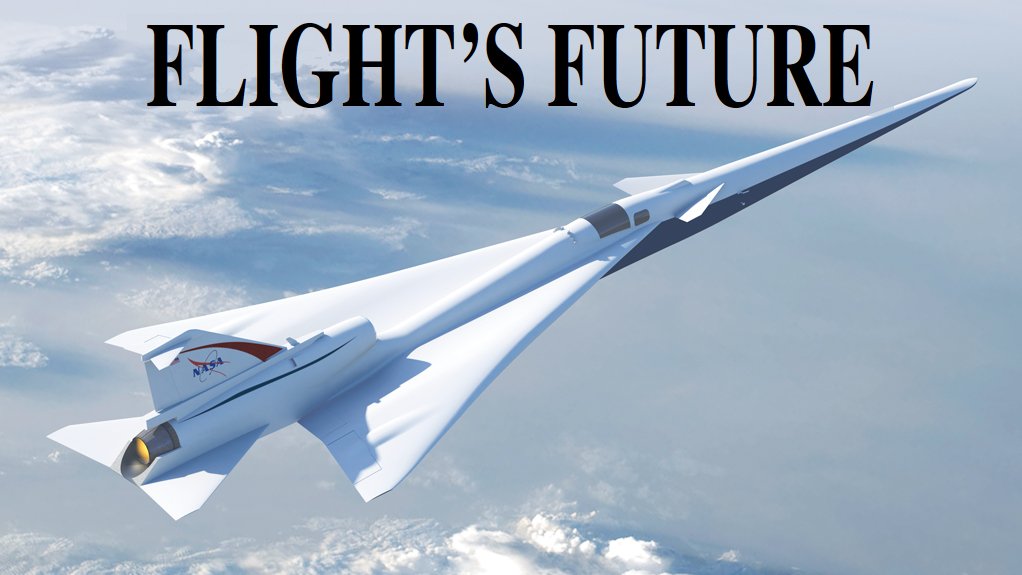Nasa outlines the developments to watch in civil aeronautics
The global aviation industry continues to be a rapidly growing sector, far from reaching maturity. This was stressed at the recent International Forum for Aviation Research (IFAR) open session at the Council for Scientific and Industrial Research (CSIR) International Convention Centre (ICC), in Pretoria, by US National Aeronautics and Space Administration (Nasa) associate administrator for the Aeronautics Research Mission Directorate Dr Jaiwon Shin. “Aviation is not a dying industry; it is not a mature industry. It is growing in leaps and bounds,” he affirmed. “This is because countries are getting richer. In a lot of developing countries, aviation demand is growing significantly.
“Many countries have chosen aviation as a growth engine for their economies,” he noted. “Dubai, in the United Arab Emirates, is a really good example.” Including the activities of national carrier Emirates, Dubai hopes to generate 40% of its gross domestic product from aviation.
A striking development is that, just as in the 1930s and 1940s, a lot of very wealthy entrepreneurs are becoming involved in aviation, a sector they know little about. Google and Amazon becoming involved with unmanned aerial vehicles (UAVs) is a good example. “It could be a fad . . . It does not look like a fad.” Technology convergence is happening in every sector, with revolutionary impacts. “A renaissance of aviation is upon us,” he argued.
For South Africa, because of its aviation infrastructure, he suggested: “This might be a golden opportunity . . . A lot of entities and countries . . . are moving into this.” The new technologies (small UAVs, networking, the Internet of Things, and so on) opened the potential for aviation to move from a high-technology but low-volume production industry to a high-technology, high-volume production sector. High-volume production would bring costs down.
“A country like South Africa may be very well positioned to catch this new market,” stated Shin. But penetrating this new market would require the building of an ecosystem of universities, government- funded research institutes (like the CSIR, although the CSIR is actually partly State-funded) and businesses. “To make [such] an ecosystem like a well-oiled machine is not an easy thing to do!”
FUTURE TRENDS
In his address to the Aeronautical Society of South Africa (AeSSA) 2017 Conference (which followed directly on the IFAR and was also held at the CSIR ICC), Shin surveyed some of the issues concerning civil aeronautics over the next 25 to 30 years that Nasa was looking at, first sketching the background against which they would develop. “Global competition in aviation is rising. Aviation is really thriving. Global wealth is shifting from North America to the Asia-Pacific region. We know all that. The world population is really moving to urban areas. When you think about long-distance travel, there is really no alternative to aviation to connect those metropolitan areas. So, the competition is on!”
The world will need more than 36 000 new airliners, both to replace existing aircraft and to meet the growing demand over the next 20 years. These will have a combined value of $4-trillion to $5-trillion – hence, the increasing competition in the airliner manufacturing sector, with such new entries (in the single- aisle category) as Canada’s Bombardier C-Series, now in operational service (although this programme became 50.01%-owned by Airbus in October), China’s Comac C919 (the prototype of which is now flying) and Russia’s Irkut MC-21 (also often referred to as the MS-21), the prototype of which is also now in flight test. (Irkut is a subsidiary of the United Aircraft Corporation, of which such renowned names as Ilyushin, Mikoyan, Sukhoi, Tupolev and Yakovlev are now subsidiaries.)
“There will be a lot of consolidations,” he observed. “We’ve already seen Airbus take a large share in the C-Series. There will be jostling [in the market]. Competition is healthy – competition brings innovation. We should welcome competition.
“Game-changing technologies are mostly based on the digital revolution, digital transformation,” he pointed out. “Without the digital revolution, additive manufacturing three-dimensional – or 3D – printing would not have been possible.” In addition to 3D printing, other key technologies he identified were the Internet of Things, digital twins (digital copies of physical objects and indeed also of processes and services), robotics, artificial intelligence and autonomy. In aeronautics, these together would result in smarter aeroplanes and smarter maintenance of aircraft.
Regarding power plants, the “workhorse, the enabler, of the commercial aviation we enjoy” is the gas turbine. Its latest iteration is the high bypass ratio turbofan, with fan diameters that exceed nine feet (2.74 m), a diameter that is not much narrower than the fuselage of a Boeing 737 airliner. But gas turbine design has been approaching a plateau, a situation from which it is being rescued by 3D Printing. “[W]ith additive manufacturing, you can truly manufacture the design we always wanted to have, without the limitations imposed by machining,” he highlighted. And machining imposes a lot of limitations on what can actually be manufactured. Now, with 3D Printing, continuous further improvements in gas turbine engines will be possible, and the expected plateau will be replaced by another design upswing (or design S-curve), leading to further developmental S-curves in the future.
Another area of power plant research is hybrid electrical systems. Hybrid electrical propulsion would greatly reduce “objectionable noise”, fuel expenditure and carbon emissions. Such a system would use a turbofan engine as a generator, producing electricity that would either directly power electric motors driving, for example, ducted fans, or keep charged batteries that would, in turn, power those electric motors. “There are a lot of challenges, of course; it’s not a done deal,” he cautioned. But Nasa is investing a lot in developing these technologies.
Shin also observed that high bypass ratio turbofans were so big that integrating them onto conventional airframes was becoming a significant challenge. Additionally, the traditional tube-and-wings airframe for airliners was very close to its limit in terms of aerodynamic refinement. Together, these factors are pushing consideration of radically different airframe concepts for airliners. One such is the blended-wing-body (BWB) configuration. Such designs are much more aerodynamically efficient than the current conventional layout, and allow the mounting of very large diameter turbofans on pylons above the airframe, and not under the wings, thereby eliminating the problem of ground clearance. BWBs could result in 40% to 50% savings in fuel consumption, in comparison to conventional designs.
Then there are UAVs. He noted that the US Federal Aviation Administration had forecast that there would be seven-million UAVs flying in the US by 2020. “If you can think of an application, nine out of ten times drones can deliver that application for you.” That was proving especially true for small drones, which had “erupted” onto the scene, taking everyone by surprise. “The big-time challenge is not building the vehicle itself – it’s not really high tech at all; it’s an impressive feat of engineering. The challenge is the operating system and air traffic management. These are the big issues. How do you safely scale up small drone operations to make them commercially viable? This is the real challenge.”
Related to UAVs are Urban Air Mobility (UAM) vehicles, which use similar technologies and create similar challenges. “A lot of legitimate and start-up companies are working on [such] concepts of personal air vehicles,” he said. “This is super exciting. If this happens, it really could revolutionise aviation.” It would bring in automotive-style mass production to the aviation industry. Having people able to fly around cities in their UAMs, instead of driving in cars, would have wider consequences as well. “If we revolutionise urban mobility using this air mobility, we’ll actually open a lot of surfaces for [use as] something else.”
Common trends for both UAVs and UAMs include on-demand availability; all-electric propulsion; vertical take-off and landing capability; and fully auto- nomous flight. The challenges for both include noise, visual barriers, privacy, and cybersecurity. Most of the challenges are, in fact, social rather than technical.
FAST FLIGHT
Supersonic commercial flight is also an area of significant research by Nasa, which has completed the design of, and hopes to soon build, a technology demonstrator aircraft to establish that it is possible to attenuate sonic booms to such a degree that it will permit overland supersonic commercial flight. Construction of this aircraft now just awaits the approval of the Nasa budget by the US Congress.
“Why are we working on supersonics? Why is this so important? . . . People want to go places, and speed is valued in that,” explained Nasa Advanced Air Vehicle Programme Director Jay Dryer. He was also addressing the AeSSA 2017 Conference (and also attended the Eighth Summit of the International Forum of Aviation Research). “There really is an international interest in this area. The reason is that it connects people around the world.”
Currently, overland commercial supersonic flight is banned worldwide, because of the noise of the sonic boom created by aircraft flying supersonically. This is like an explosion in its intensity. Only if this intensity is significantly reduced can overland nonmilitary supersonic flight be allowed.
Research has shown that, at supersonic speeds, various parts of an aircraft’s airframe generate shockwaves. These shockwaves then coalesce to create what is known as an N-wave, and it is this N-wave that is audible as the explosive sonic boom. The aim of Nasa research has been to come up with a design of aircraft that would ensure that the various shockwaves it generated at supersonic speeds would not coalesce to form an N-wave. This would result in what is called a low sonic boom aircraft.
The first step in designing such an aircraft, he pointed out, was computer modelling. This was followed by testing airframe models in wind tunnels. “We’ve done extensive work in the [wind] tunnels. This gave us a lot of confidence in our computational models.”
Initial testing of people’s responses to low sonic booms has been done, using an F-18 fighter to fly a particular diving manoeuvre, which generates a low sonic boom in one (known) direction (but focused sonic booms in other directions). This aircraft will soon be used to carry out low sonic boom tests in coastal communities in the US (so that the full-scale booms will be directed out to sea).
But such coastal tests will not in themselves be adequate to prove the concept – hence, the need for the dedicated test aircraft, or X-plane in US terminology. This will be a manned aircraft, so that it can easily (in terms of air safety regulations) be operated over populated areas (which is the whole point of the programme).
It will have a maximum speed range around 1.6 times the speed of sound (Mach 1.6, in aviation terminology), which will allow the use of aluminium in the airframe and so keep costs down. Although the airframe itself will be new, as many systems and subsystems as possible will be taken from existing production aircraft, also to reduce costs.
Nasa’s schedule is that the aircraft will start flying at the end of US financial year (FY) 2020 or the start of FY 2021. A US FY starts on October 1 every year. Nasa is eager to attract international cooperation for this pro- gramme. The agency stresses that the aircraft is a demon- strator, not a prototype. Any low sonic boom commercial prototype aircraft would have to be developed by industry.
“There are a lot of challenges, of course,” stated Shin. There is the tremendous investment in airport infrastructure designed to handle conventional airliner designs. How would BWBs, for example, fit in? What changes would be needed at airports to handle them? Moreover, for decades, radical new designs would have to be operated alongside existing conventional designs. “Cybersecurity [is] a big cloud hanging over our heads.” There are ever-more stringent environmental and noise regulations that will have to be met. And then there is public acceptance, which is a bigger problem than regulation. “The future is to be decided! We are technologists: we believe technological challenges can be overcome!”
Article Enquiry
Email Article
Save Article
Feedback
To advertise email advertising@creamermedia.co.za or click here
Comments
Announcements
What's On
Subscribe to improve your user experience...
Option 1 (equivalent of R125 a month):
Receive a weekly copy of Creamer Media's Engineering News & Mining Weekly magazine
(print copy for those in South Africa and e-magazine for those outside of South Africa)
Receive daily email newsletters
Access to full search results
Access archive of magazine back copies
Access to Projects in Progress
Access to ONE Research Report of your choice in PDF format
Option 2 (equivalent of R375 a month):
All benefits from Option 1
PLUS
Access to Creamer Media's Research Channel Africa for ALL Research Reports, in PDF format, on various industrial and mining sectors
including Electricity; Water; Energy Transition; Hydrogen; Roads, Rail and Ports; Coal; Gold; Platinum; Battery Metals; etc.
Already a subscriber?
Forgotten your password?
Receive weekly copy of Creamer Media's Engineering News & Mining Weekly magazine (print copy for those in South Africa and e-magazine for those outside of South Africa)
➕
Recieve daily email newsletters
➕
Access to full search results
➕
Access archive of magazine back copies
➕
Access to Projects in Progress
➕
Access to ONE Research Report of your choice in PDF format
RESEARCH CHANNEL AFRICA
R4500 (equivalent of R375 a month)
SUBSCRIBEAll benefits from Option 1
➕
Access to Creamer Media's Research Channel Africa for ALL Research Reports on various industrial and mining sectors, in PDF format, including on:
Electricity
➕
Water
➕
Energy Transition
➕
Hydrogen
➕
Roads, Rail and Ports
➕
Coal
➕
Gold
➕
Platinum
➕
Battery Metals
➕
etc.
Receive all benefits from Option 1 or Option 2 delivered to numerous people at your company
➕
Multiple User names and Passwords for simultaneous log-ins
➕
Intranet integration access to all in your organisation



















